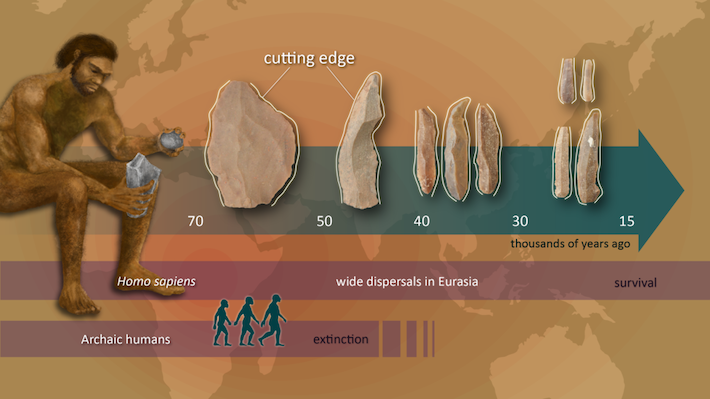 NAGOYA, JAPAN—According to a statement released by Nagoya University, a study conducted by Seiji Kadowaki of Nagoya University and his colleagues has explored the transition from the Middle Paleolithic period, in which modern humans and Neanderthals made similar stone tools, with the Upper Paleolithic period, often understood as a time when other human species went extinct while modern humans developed new cognitive abilities and technologies that gave then an advantage as they then expanded across Eurasia. Kadowaki and his team examined stone tools unearthed at five sites in southern Jordan that were made between 69,000 and 15,000 years ago, from the Late Middle Paleolithic through the Upper Paleolithic periods. First, they measured the length of each tool’s cutting edge, then compared it to the mass of the stone, in order to quantify how efficiently the raw stone material had been used. The study determined that modern humans did not become more economical in their consumption of raw stone materials until after their initial dispersals into Eurasia, at the same time they were developing more portable bladelet technology. “In terms of cutting-edge productivity, Homo sapiens did not start to spread to Eurasia after a quick revolution in stone tool technology, but rather the innovation in the ‘cutting-edge’ productivity occurred later, in tandem with the miniaturization of stone tools like bladelets,” Kadowaki explained. Read the original scholarly article about this research in Nature Communications. For more, go to "Neanderthal Tool Time."
NAGOYA, JAPAN—According to a statement released by Nagoya University, a study conducted by Seiji Kadowaki of Nagoya University and his colleagues has explored the transition from the Middle Paleolithic period, in which modern humans and Neanderthals made similar stone tools, with the Upper Paleolithic period, often understood as a time when other human species went extinct while modern humans developed new cognitive abilities and technologies that gave then an advantage as they then expanded across Eurasia. Kadowaki and his team examined stone tools unearthed at five sites in southern Jordan that were made between 69,000 and 15,000 years ago, from the Late Middle Paleolithic through the Upper Paleolithic periods. First, they measured the length of each tool’s cutting edge, then compared it to the mass of the stone, in order to quantify how efficiently the raw stone material had been used. The study determined that modern humans did not become more economical in their consumption of raw stone materials until after their initial dispersals into Eurasia, at the same time they were developing more portable bladelet technology. “In terms of cutting-edge productivity, Homo sapiens did not start to spread to Eurasia after a quick revolution in stone tool technology, but rather the innovation in the ‘cutting-edge’ productivity occurred later, in tandem with the miniaturization of stone tools like bladelets,” Kadowaki explained. Read the original scholarly article about this research in Nature Communications. For more, go to "Neanderthal Tool Time."
Stone Tool Innovation Studied
